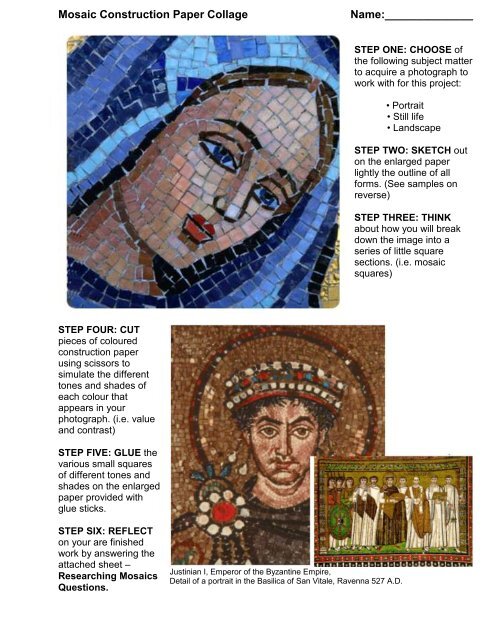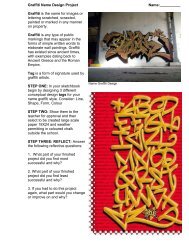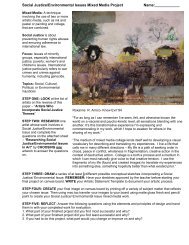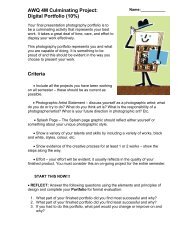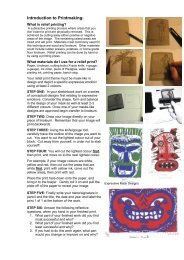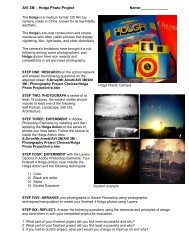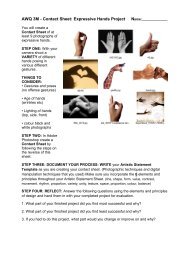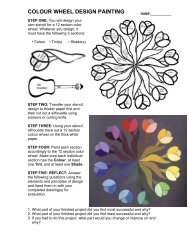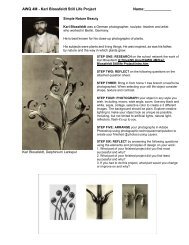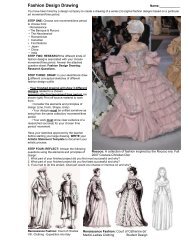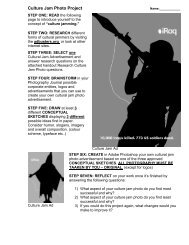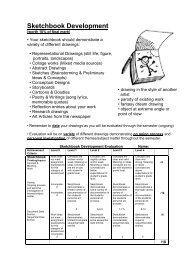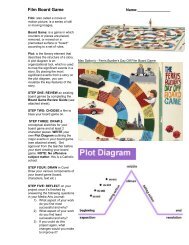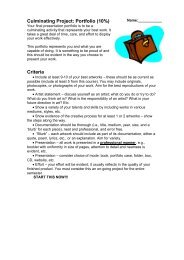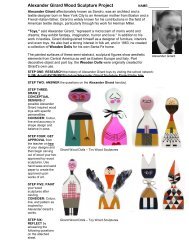Mosaic Construction Paper Collage
Mosaic Construction Paper Collage
Mosaic Construction Paper Collage
Create successful ePaper yourself
Turn your PDF publications into a flip-book with our unique Google optimized e-Paper software.
<strong>Mosaic</strong> <strong>Construction</strong> <strong>Paper</strong> <strong>Collage</strong> Name:______________<br />
STEP FOUR: CUT<br />
pieces of coloured<br />
construction paper<br />
using scissors to<br />
simulate the different<br />
tones and shades of<br />
each colour that<br />
appears in your<br />
photograph. (i.e. value<br />
and contrast)<br />
STEP FIVE: GLUE the<br />
various small squares<br />
of different tones and<br />
shades on the enlarged<br />
paper provided with<br />
glue sticks.<br />
STEP SIX: REFLECT<br />
on your are finished<br />
work by answering the<br />
attached sheet –<br />
Researching <strong>Mosaic</strong>s<br />
Questions.<br />
Justinian I, Emperor of the Byzantine Empire,<br />
Detail of a portrait in the Basilica of San Vitale, Ravenna 527 A.D.<br />
STEP ONE: CHOOSE of<br />
the following subject matter<br />
to acquire a photograph to<br />
work with for this project:<br />
• Portrait<br />
• Still life<br />
• Landscape<br />
STEP TWO: SKETCH out<br />
on the enlarged paper<br />
lightly the outline of all<br />
forms. (See samples on<br />
reverse)<br />
STEP THREE: THINK<br />
about how you will break<br />
down the image into a<br />
series of little square<br />
sections. (i.e. mosaic<br />
squares)
K/U: Researching <strong>Mosaic</strong>s Questions Name:______________<br />
1. What is <strong>Mosaic</strong> Art?<br />
Select one historical mosaic and identify the formal, expressive and technical qualities of the work.<br />
Formal Qualities:<br />
Expressive Qualities:<br />
Technical Qualities:<br />
2. What do you think is the original purpose of the historical mosaic was?<br />
3. Identify sensory, formal, expressive, symbolic, and technical qualities in your own mosaic and make<br />
specific connections to historical mosaic(s) studied.<br />
Formal Qualities:<br />
Symbolic Qualities:<br />
Expressive Qualities:<br />
Technical Qualities:<br />
Connections to historical mosaic(s) studied:<br />
4. Describe the stages of the design process (research, conceptual sketches, experimentation, revision(s))<br />
followed in the creation of your mosaic:<br />
5. What do you think was the most successful part of your work and why?<br />
6. What do you think was the least successful part of your work and why?<br />
7. If you had to do this project again, what changes would you make to your work and why?
<strong>Mosaic</strong> <strong>Construction</strong> <strong>Paper</strong> <strong>Collage</strong> Rubric Name:__________<br />
Achievement<br />
Criteria<br />
Thinking/<br />
Inquiry<br />
Concept & Meaning:<br />
<strong>Mosaic</strong> <strong>Construction</strong> <strong>Paper</strong><br />
Technique: Shades and<br />
Tones<br />
Knowledge/<br />
Understanding<br />
Creativity & Originality<br />
Composition<br />
Application/<br />
Creation<br />
Value<br />
(Shades & Tones)<br />
Process:<br />
Demonstration of Skill<br />
Development<br />
& Following Procedures<br />
including Clean Up<br />
Application of shapes,<br />
Neatness &<br />
Completion<br />
Detail:<br />
Shapes<br />
Communication<br />
Clarity and Accuracy:<br />
<strong>Collage</strong> Techniques<br />
And<br />
Arrangement of shapes<br />
Reflection Questions<br />
Level 0<br />
Work does not<br />
meet<br />
assignments<br />
expectations<br />
for this<br />
category.<br />
Incomplete.<br />
0<br />
Work does not<br />
meet<br />
assignments<br />
expectations<br />
for this<br />
category.<br />
Incomplete.<br />
0<br />
Work does not<br />
meet<br />
assignments<br />
expectations<br />
for this<br />
category.<br />
Incomplete.<br />
Incomplete.<br />
0<br />
Work does not<br />
meet<br />
assignments<br />
expectations<br />
for this<br />
category.<br />
Incomplete.<br />
0<br />
Incomplete.<br />
0<br />
Incomplete.<br />
0<br />
Incomplete.<br />
0<br />
Incomplete.<br />
0<br />
Level 1<br />
Concept is unclear and/or<br />
weak.<br />
Meaning or ideas<br />
conveyed are not on par<br />
with student grade level.<br />
0.5<br />
The completed work is<br />
largely unoriginal and not<br />
creative in execution.<br />
Many exemplars of<br />
similar work exist.<br />
0.5<br />
Composition is<br />
unbalanced. Little thought<br />
has been given to the<br />
placement of elements &<br />
principles on the page, or<br />
to the correct ratio of<br />
positive to negative<br />
space.<br />
0.25<br />
Work demonstrates no<br />
areas of extreme black or<br />
white. The composition<br />
does not contain sufficient<br />
value to reflect three<br />
dimensionality.<br />
1<br />
Student demonstrates<br />
limited effectiveness in<br />
demonstrating the<br />
process of following<br />
procedures and skill<br />
development.<br />
5<br />
The submitted work<br />
appears obviously<br />
incomplete. Much more<br />
effort could have been<br />
included: time has<br />
obviously been<br />
mismanaged. Poor<br />
application of shapes, not<br />
neatly applied.<br />
1<br />
Work demonstrates<br />
limited detail.<br />
1<br />
Work demonstrates<br />
limited degree of clarity<br />
and accuracy in collage<br />
techniques and<br />
arrangement of shapes.<br />
0.5<br />
Answers are<br />
vague/incomplete.<br />
0.5<br />
Level 2<br />
Concept is slightly unclear<br />
and/or weak.<br />
Meaning or ideas conveyed<br />
are below expectations for<br />
student’s grade level.<br />
Applies some of the<br />
elements & principles of<br />
design while composing<br />
work.<br />
0.5 - 1.0<br />
The completed work is<br />
largely unoriginal and not<br />
creative in execution. Many<br />
exemplars of similar work<br />
exist.<br />
0.5 - 1.0<br />
Composition is<br />
semi-balanced. Some<br />
thought has been given to<br />
the placement of elements<br />
& principles on the page<br />
and the correct ratio of<br />
positive to negative space.<br />
0.5<br />
Work demonstrates few<br />
areas of extreme black or<br />
white. The composition is<br />
grey overall or contains<br />
minimal value to reflect<br />
three dimensionality.<br />
2<br />
Student demonstrates<br />
some effectiveness in<br />
demonstrating the process<br />
of following procedures and<br />
skill development.<br />
6 - 6.5<br />
The submitted work<br />
appears slightly<br />
incomplete. Some<br />
additional effort could have<br />
been included: time has<br />
been slightly mismanaged.<br />
Somewhat neat application<br />
of shapes, somewhat<br />
nearly applied.<br />
2<br />
Work demonstrates some<br />
detail.<br />
2<br />
Work demonstrates some<br />
degree of clarity and<br />
accuracy in collage<br />
techniques and<br />
arrangement of shapes.<br />
0.5 - 1.0<br />
Answers are somewhat<br />
clear and complete.<br />
0.5 - 1.0<br />
Level 3<br />
Concept is clear and valid.<br />
Meaning or ideas conveyed<br />
are on par with student’s<br />
grade level. Applies<br />
considerable elements &<br />
principles of design while<br />
composing work.<br />
1.0 - 1.75<br />
The completed work is<br />
largely unoriginal and not<br />
creative in execution. Many<br />
exemplars of similar work<br />
exist.<br />
1.0 - 1.75<br />
Composition is mostly<br />
balanced. Adequate<br />
thought has been given to<br />
the placement of elements<br />
& principles on the page<br />
and the correct ratio of<br />
positive to negative space.<br />
0.75<br />
Work demonstrates some<br />
areas of extreme black or<br />
white. The composition<br />
contains sufficient value to<br />
reflect three dimensionality.<br />
3 - 4<br />
Student demonstrates<br />
considerable effectiveness<br />
in demonstrating the<br />
process of following<br />
procedures and skill<br />
development.<br />
7 - 7.5<br />
The submitted work<br />
appears slightly<br />
incomplete. Some<br />
additional effort could have<br />
been included: time has<br />
been slightly mismanaged.<br />
Good application of shapes<br />
– neatly applied.<br />
3 - 4<br />
Work demonstrates<br />
substantial detail.<br />
3 - 4<br />
Work demonstrates<br />
considerable degree of<br />
clarity and accuracy in<br />
collage techniques and<br />
arrangement of shapes.<br />
1.0 - 1.75<br />
Answers are clear and<br />
complete.<br />
1.0 - 1.75<br />
A1. The Creative Process: apply the creative process to create a variety of art works, individually and/or collaboratively;<br />
Level 4<br />
Concept is clear and<br />
strong.<br />
Meaning or ideas<br />
conveyed are above<br />
expectations for student’s<br />
grade level. Applies<br />
substantial elements &<br />
principles of design while<br />
composing work.<br />
2<br />
The completed work is<br />
largely unoriginal and not<br />
creative in execution.<br />
Many exemplars of<br />
similar work exist.<br />
2<br />
Composition is balanced.<br />
Much thought has been<br />
given to placement of<br />
elements & principles on<br />
the page and the correct<br />
ratio of positive to<br />
negative space.<br />
1<br />
Work demonstrates exact<br />
and balanced amounts of<br />
extreme blacks, whites &<br />
greys. The composition<br />
contains balanced value<br />
to reflect three<br />
dimensionality.<br />
5<br />
Student demonstrates<br />
superior effectiveness in<br />
demonstrating the<br />
process of following<br />
procedures and skill<br />
development.<br />
8 - 10<br />
The submitted work<br />
appears slightly<br />
incomplete. Some<br />
additional effort could<br />
have been included: time<br />
has been slightly<br />
mismanaged. Superior<br />
application of shapes –<br />
neatly applied.<br />
5<br />
Work demonstrates<br />
exemplary detail.<br />
5<br />
Work demonstrates high<br />
degree of clarity and<br />
accuracy in collage<br />
techniques and<br />
arrangement of shapes.<br />
2<br />
Answers are clear &<br />
exemplary.<br />
2<br />
/2<br />
/2<br />
/1<br />
/5<br />
/10<br />
/5<br />
/5<br />
/2<br />
/2<br />
/34
A1.1 use a variety of strategies, individually and/or collaboratively, to generate Ideas and to develop plans for the creation of art works (e.g., in small<br />
groups, use brainstorming, research, concept webs, and/or mind maps to generate original and imaginative ideas; filter their ideas to select a suitable<br />
one to serve as the basis for their art work; use notes and/or thumbnail sketches to help them develop clear and flexible plans that show attention to<br />
detail; revise their plans on the basis of peer- and self-assessment)<br />
A1.2 use experimentation, reflection, and revision when producing a variety of art works in each of the following areas: drawing, sculpture, painting,<br />
printmaking, and mixed media (e.g., experiment with a variety of materials/media, techniques, and tools to find ones that are appropriate for their<br />
planned art work; reflect on their preliminary work and on feedback from their peers before revising their art work)<br />
A1.3 document their use of the creative process in a portfolio (e.g., include evidence of their conceptual, creative, and technical skills; include<br />
thumbnail sketches, checklists, and/or graphic organizers to show evidence of experimentation, reflection, and revision), and refer to this portfolio to<br />
reflect on how effectively they have used the creative process<br />
A2. The Elements and Principles of Design: apply elements and principles of design to create artworks for the purpose of self-expression and to communicate<br />
ideas, information, and/or messages;<br />
A2.1 use various elements and principles of design to create art works that express personal feelings and/or communicate emotions to an audience<br />
A2.2 apply elements and principles of design as well as art-making conventions to create art works that communicate ideas, information, or<br />
messages, and/or that convey a point of view on an issue<br />
A3. Production and Presentation: produce art works, using a variety of media/materials and traditional and/or emerging technologies, tools, and techniques, and<br />
demonstrate an understanding of a variety of ways of presenting their works and the works of others.<br />
3.1 explore and experiment with a variety of materials/media, including alternative media, and traditional and/or emerging technologies, tools, and<br />
techniques, and apply them to create art works (e.g., use recycled, found, and/or handmade objects to make a mosaic or assemblage; experiment<br />
with technology such as scanners or digital cameras; use appropriate techniques when working with media such as plaster, paint, charcoal, or clay;<br />
combine photo transfers with watercolour and graphite)<br />
B1. The Critical Analysis Process: demonstrate an understanding of the critical analysis process by examining, interpreting, evaluating, and reflecting on various<br />
art works;<br />
B1.2 identify and describe the elements and principles of design used in their own art works and the works of others, and describe their effects (e.g.,<br />
how line, colour, and shape are used to create emphasis, mood, and/or movement)<br />
B1.3 explore and interpret a variety of art works, both historical and contemporary, to identify and describe their purpose and style, the materials used,<br />
and the meanings the works convey<br />
B1.4 use a variety of strategies (e.g., peer- and self-assessment, formal critiques, feedback and reflection following public displays) to identify and<br />
reflect on the qualities of their own art works and the works of others, and evaluate the effectiveness of these works<br />
B2. Art, Society, and Values: demonstrate an understanding of how art works reflect the societies in which they were created, and how they can affect personal<br />
values;<br />
B2.1 identify and describe the function of various types of art works (e.g., graffiti, propaganda art, religious art, satirical works; works that focus on<br />
personal narrative or anthropological study) in past and present societies<br />
B2.2 identify and describe ways in which various art works reflect the societies in which they were created<br />
C1. Terminology: demonstrate an understanding of, and use correct terminology when referring to, elements, principles, and other components related to visual<br />
arts;<br />
C1.1 use appropriate terminology related to elements and principles of design when creating and analysing art works (e.g., when comparing the use<br />
of line, colour, shape, and contrast in African textiles with those in medieval illuminated manuscripts; when demonstrating or describing how to create<br />
an area of emphasis using colour, contrast, and shape)<br />
C1.2 use appropriate vocabulary to describe techniques, materials, and tools when creating and presenting visual art works (e.g., dry brush; layering;<br />
pinhole camera; washes; techniques and tools used to create flipbooks, illuminated manuscripts, mosaics, stained glass works)<br />
C1.3 identify and describe the stages of the creative process and the critical analysis process (e.g., how reflection relates to the other stages of the<br />
creative<br />
process)<br />
C2. Conventions and Techniques: demonstrate an understanding of conventions and techniques used in the creation of visual art works;<br />
C2.1 demonstrate an understanding of a variety of techniques that artists use to achieve specific effects (e.g., the use of atmospheric perspective to<br />
create the perception of depth, the use of additive and subtractive sculpture to explore space and form, the use of layering to provide a sense of<br />
dimensionality)<br />
C3. Responsible Practices: demonstrate an understanding of responsible practices in visual arts.<br />
C3.2 demonstrate an understanding of safe and conscientious practices associated with the use of materials, tools, and technologies in visual arts,<br />
and apply these practices when creating and/or presenting art works (e.g., use appropriate precautions when dealing with hazardous materials; adopt<br />
protective measures when using sharp tools; keep their work space clean and free of physical and other hazards; demonstrate respect for classroom<br />
facilities, tools, equipment, and technological devices)


